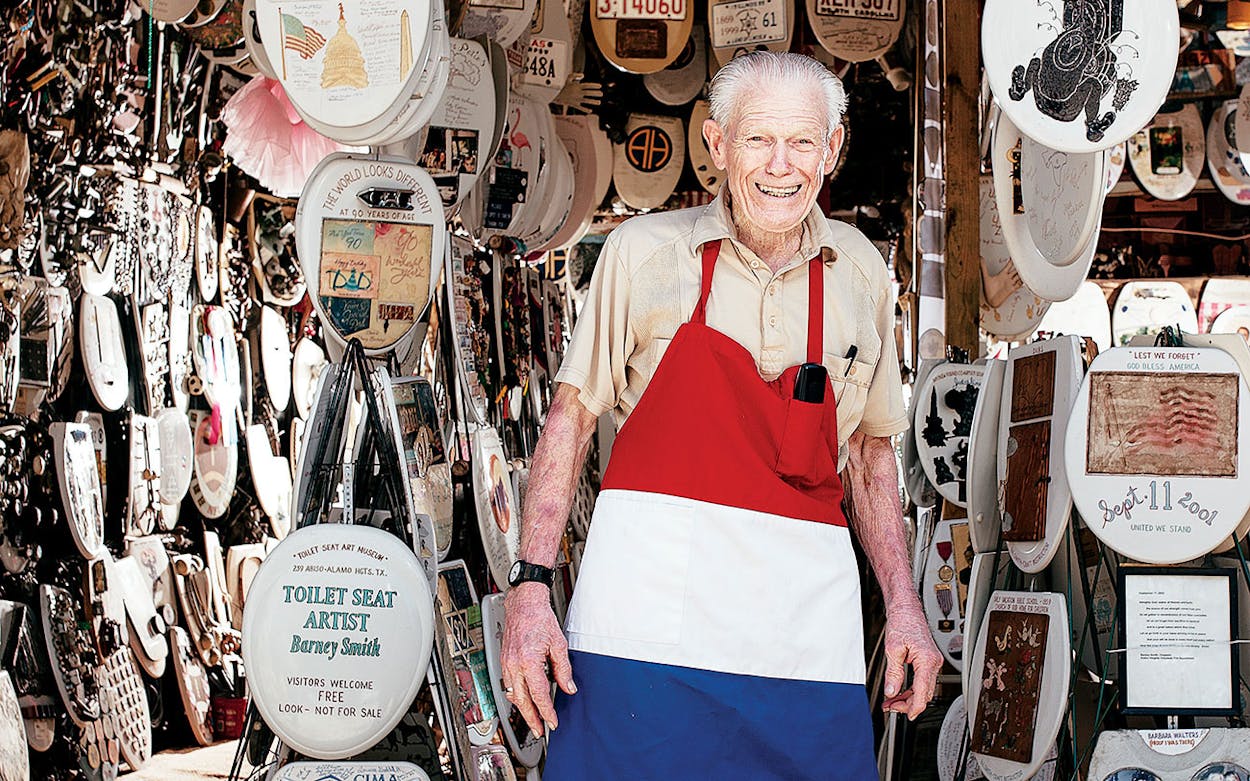This article appeared in the September 2017 issue of Texas Monthly with the headline “Circling the Drain.”
Ever feel the urge to visit Barney Smith and his world-famous Toilet Seat Art Museum? Well, it’s time to go or get off the pot. Smith is 96 and not sure how much longer he can hold it. “Don’t wait too long, because I may not be here,” he says.
A retired plumber and lifelong artist, Smith has been decorating toilet seat lids for more than half a century, and his free museum made a splash when it opened to the public in 1992. At last count, he is the proud owner of 1,310 toilet seats, which are crammed into nearly every inch of wall space in an old metal garage behind Smith’s house, in Alamo Heights, a small city completely surrounded by San Antonio. “There’s a lot of history in here,” he said during a visit in late July.
Indeed, every seat tells a story. He’s got a toilet seat festooned with casket handles and another with turkey beards, a chunk of space shuttle debris on one and some of his mother’s buttons on a seat nearby. The fields of cosmetic dentistry and gastroenterology are also well represented. When a hornet stung Smith on the head, he obliterated the entire colony and preserved its dead on one of his seats. The first seat he decorated—so long ago that he doesn’t remember the precise year—featured a pair of deer antlers, and his latest work includes a handwritten note to Smith from NBA coach Gregg Popovich: “Don’t fall in while rooting for the Spurs!”
Smith jabbed his bamboo walking cane toward a seat that is festooned with a small piece of a particularly palatial flusher. “This is from a part of Saddam Hus-
sein’s toilet that a Navy commander gave to me,” he said (it has a “letter of authenticity” mounted on the back). There are also numerous tributes to Smith’s 74 years of marriage to his wife, Velma Louise, who died in 2014.
Over the past quarter century, Smith has entertained visitors from every state and 81 nations. When he could still travel, he made the rounds of national TV talk shows; then he’d come home and create artwork to commemorate each appearance. Smith still likes to show off the seats devoted to Barbara Walters and Montel Williams.
But Smith’s twenty-sixth summer at the museum has been a rough one. “That heat just wears him out,” says his daughter, Julia Murders.
Smith was always a short man, but in recent years his back has become severely hunched; it’s difficult for him to open the museum’s corrugated-metal bay doors by himself. And so, on July 11, he announced that it was about time to lower the lid on the whole operation. “This might be the last week that I open it up, I don’t know,” he says. “I’ve got a lot of traffic coming through here, but I’m getting so old and feeble that I’m putting it on the market for sale.”
Smith admits to not knowing squat about the monetary value of the museum. While not exactly flush with cash, he also has no interest in dumping it with the highest bidder. Rather, he and his daughter are fielding inquiries from potential buyers who promise to keep the museum intact and open to the public in a new location.
“We don’t have a price. We’re taking offers right now,” she says. “We just want to keep it together. That’s the most important thing. Daddy wants to know that it’s all together, and it’s not going to be split up, because his is the only toilet seat art museum in the United States.”
In fact, it appears to be the only one in the world.
For now, Smith is continuing to open the museum by appointment for a couple of hours in the afternoons. On a Saturday in midsummer, half a dozen tourists mingled with families of military service members in the sweltering garage. When a preteen from North Carolina inched toward the exit, Smith caught him. “Are you getting ready to go? Come on back in and look around. You haven’t even seen the piece of the Berlin Wall!”
“I’m getting a lot of kick coming out here talking to people that are from different states,” Smith said. He briefly struck up a conversation with a woman from Arizona who’d been combing the museum for an item inspired by Jimmy Buffett’s oeuvre; she asked Smith if he had a Margaritaville toilet on display, and he had no idea what she was talking about. “It’s just like kinfolks coming to see me,” he continued, after she wandered off again. “I love having them around.”
After a couple of hours, Smith was worn out. The day’s last visitors helped him close the garage doors, and he hobbled across the backyard to the air-conditioning inside his house, where he still decorates toilet seats late into the night. Even if Smith finds a buyer for the collection, he’s not retiring. He has too many ideas for new toilet seats.
“I’ll go on up as far as I can go until the Lord says that’s enough,” he insists. “I’m going to make them until I die.”









